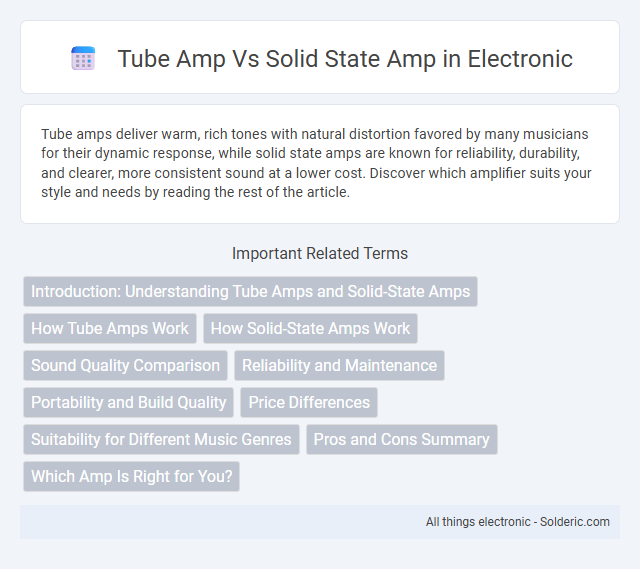Tube amps deliver warm, rich tones with natural distortion favored by many musicians for their dynamic response, while solid state amps are known for reliability, durability, and clearer, more consistent sound at a lower cost. Discover which amplifier suits your style and needs by reading the rest of the article.
Comparison Table
| Feature | Tube Amp | Solid State Amp |
|---|---|---|
| Technology | Vacuum tubes amplify signal | Transistors amplify signal |
| Sound Quality | Warm, rich, harmonic distortion | Clean, precise, less distortion |
| Durability | Fragile tubes prone to wear | Robust, longer lifespan |
| Maintenance | Regular tube replacement needed | Low maintenance |
| Weight | Heavier due to tubes and transformers | Lightweight design |
| Cost | Generally more expensive | More affordable |
| Usage | Preferred by audiophiles and pros for tone | Common in practice and affordable setups |
| Dynamic Response | Responsive to subtle playing nuances | Less dynamic sensitivity |
Introduction: Understanding Tube Amps and Solid-State Amps
Tube amps utilize vacuum tubes to amplify sound, producing warm, rich tones favored by many musicians for their natural distortion and dynamic response. Solid-state amps rely on semiconductor transistors, offering reliable performance, lighter weight, and greater affordability while delivering clean and consistent audio. Comparing tube amps and solid-state amps involves considering tonal characteristics, maintenance, durability, and price to determine the best option for specific audio needs.
How Tube Amps Work
Tube amps utilize vacuum tubes to amplify audio signals by controlling electron flow between cathodes and anodes within a vacuum-sealed glass tube, which creates warm and harmonically rich sound characteristics. The natural distortion and compression produced by tube amplification contribute to its preferred tonal qualities among guitarists and audiophiles. Tube amps are typically less efficient and generate more heat compared to solid-state amplifiers, which rely on semiconductor transistors for signal amplification.
How Solid-State Amps Work
Solid-state amps use transistor circuits to amplify audio signals, providing a reliable and lightweight alternative to tube amps. These amplifiers rely on semiconductor components to regulate voltage and current, producing a clean and consistent sound with less maintenance. Your choice between solid-state and tube amps affects tone and durability, with solid-state models favoring efficiency and stability.
Sound Quality Comparison
Tube amps deliver warm, rich tones with natural harmonic distortion that many musicians and audiophiles prefer for their dynamic response and organic sound character. Solid state amps provide cleaner, more consistent sound reproduction with higher headroom and lower maintenance, making them ideal for clarity and reliability. Your choice depends on whether you prioritize the classic, expressive tonal warmth of tube amps or the precise, crisp sound quality of solid state models.
Reliability and Maintenance
Tube amps demand more frequent maintenance due to their vacuum tubes, which wear out and require periodic replacement to maintain optimal sound quality. Solid state amps offer superior reliability with fewer components prone to failure, resulting in lower maintenance costs and less downtime. Musicians often choose solid state amps for consistent performance and durability, especially in demanding environments.
Portability and Build Quality
Tube amps are generally heavier and bulkier due to their glass vacuum tubes and robust transformers, making them less portable compared to solid state amps, which are lighter and more compact thanks to their transistor-based circuits. The build quality of tube amps often reflects a vintage, handcrafted aesthetic with durable metal chassis and high-quality components, whereas solid state amps prioritize ruggedness and efficiency, often using modern materials and construction techniques for enhanced durability. Musicians seeking portability typically prefer solid state amps for gigging, while those valuing classic tone and craftsmanship lean towards tube amps despite reduced portability.
Price Differences
Tube amps generally come with a higher price tag due to their intricate construction, vintage components, and warm, rich sound qualities. Solid state amps are more affordable, offering reliable performance with lower maintenance costs, making them a cost-effective choice for many musicians. Your decision might hinge on balancing budget constraints with desired tonal characteristics.
Suitability for Different Music Genres
Tube amps excel in delivering warm, rich tones favored by blues, jazz, and classic rock musicians due to their natural harmonic distortion and dynamic response. Solid-state amps provide cleaner, more precise sound with higher reliability, making them ideal for genres like pop, metal, and electronic music where clarity and high gain are essential. Guitarists often choose tube amps for expressive, vintage sounds, while solid-state amps suit modern, high-output applications requiring consistent performance.
Pros and Cons Summary
Tube amps deliver warm, rich tones with natural compression favored by guitarists for blues and rock, but they require regular maintenance and are often heavier and less reliable than solid state amps. Solid state amps offer lightweight, durable designs with consistent sound quality, making them ideal for gigging musicians, but they can produce a less organic tone and sometimes lack the dynamic response of tube amps. Choosing between tube and solid state amps depends on priorities like tonal warmth, portability, and budget.
Which Amp Is Right for You?
Tube amps deliver warm, rich tones favored by musicians seeking vintage sound quality and natural harmonic distortion. Solid state amps offer reliable, lightweight performance with consistent sound and lower maintenance, ideal for gigging musicians or beginners. Your choice depends on whether you prioritize nostalgic tonal character or practical durability and affordability.
Tube amp vs Solid state amp Infographic

 solderic.com
solderic.com